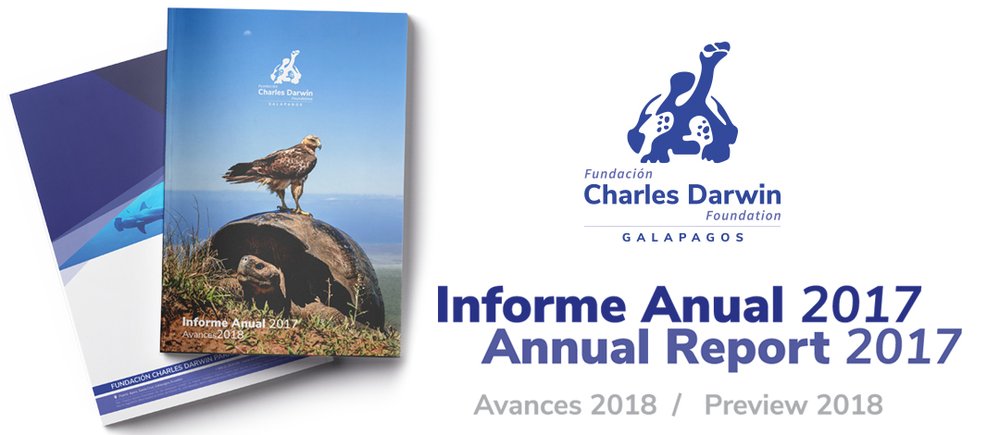
Our 2017-2018 Annual Report has been released. It features work we do to provide knowledge and assistance through scientific research to ensure the conservation in Galapagos. This document provides an overview of all projects implemented by the Charles Darwin Foundation (CDF) in Galapagos during 2017 and offers a preview of our activities through mid-2018.
Executive Director, Arturo Izurieta Valery, says the annual report presents the work of every part of the CDF:“I am pleased to bring you our report on the actions and work for 2017 and the preview of 2018. Undoubtedly, with the efforts of all those who comprise the Charles Darwin Foundation, its members, the Board of Directors, and those of us who implement the field actions with which we are entrusted, what we have achieved has been largely thanks to our generous donors.”
In 2017, we enhanced our capacity for fundraising, scientific production, and our worldwide communication channels by launching our new website. The Board of Directors continues to play a proactive role, hugely supporting the fundraising efforts, and following up on the implementation of our CDF 2016-2019 strategy. Our deepest thanks for the backing and political commitment of all governmental institutions for our work.
This document summarizes, clearly and dynamically, information generated by research projects in Galapagos. All of these projects are implemented with the backing and authorization of our most important partner, the Galapagos National Park Directorate. We also collaborate with other national and international research, conservation and academic organizations.
This report also includes summaries of the work by our administrative, financial, fundraising, operations, human resources, and information technology areas. Our donors, staff and collaborators are recognized in each section.
Dennis Geist, President of the CDF (nov 2011- nov 2018), mentions: “as you will see from this annual report, the research of the CDF continues to evolve. One thing that does not change is the tireless work of the scientists and the rest of the staff toward preserving Galapagos. They do the hard work that is making the difference in saving the native ecosystems, restoring ecosystems that have been historically upset by humans, and doing all of this while working for the interests of the human population in the islands.”
Our research efforts are organized into three main categories: marine environments, terrestrial environments and ecosystem restoration. The annual report also has sections on: promotion, communications and extension activities, knowledge management, infrastructure, inspiring stories, a visit to the Research Station, financial reporting, our donors, inter-institutional alliances, agreements, publications, scientific lectures, organizational chart, members of our General Assembly, members of our team, collaborating scientists, volunteers and scholarship grant students.
“The science dimension has acquired strong leadership and renewed energy by adding Dr. María José Barragán-P. as our Science Director at the Charles Darwin Research Station since early 2018” mentions Dr. Izurieta.
During 2017 and up to mid-2018, we have studied marine ecosystems, including green turtles, and the threats they face, analyzed samples taken from seamounts to study this ecosystem’s biodiversity, and continued studying the status of the flamingo population. We have also marked four new hammerhead sharks and seven tiger sharks, using satellite and acoustic transmitters, to understand their migration patterns and the degree to which they are protected in the Marine Reserve.
We have developed a monitoring program to assess the threat posed by plastic marine debris for species in Galapagos. We have continued with the project to restore the Los Gemelos ecosystem and the Scalesia forests on Santa Cruz Island. Using Google Earth, as a low-cost alternative, we have delimited mangrove ecosystems and beaches.
In early 2018, we have continued studying the causes of the vermilion flycatcher’s population decline, and worked to recover the small mangrove finch populations on Isabela Island.
Our efforts have continued to study the Philornis downsi fly and find solutions to lessen its impact on the landbird population.
The Galapagos Tortoise Movement Program, which is part of a collaboration between several institutions, and works with the Darwin Foundation, conducted a pilot study on Santa Cruz Island, sampling a total of 30 tortoises in agricultural zones, peri-urban areas and the National Park.
We published, jointly with WWF-Ecuador, the first Atlas of Galapagos, native and invasive species, after two years of compiling information. We are working on publishing the first inventory of deep-water invertebrates by Phylum. We have opened the new “Marine World” display at the Van Straelen Interpretation Center and in early 2018 we launched our new website. Our work continues to implement our new DataZone. We face many challenges and execute many projects in Galapagos.
“I am sure that, as 2018 draws to a close and we look toward completing 60 years of institutional life in 2019, we will continue consolidating efforts to enable Ecuador to make the best decisions for the future of this jewel of the world, so fragile, iconic, and exceptional.” Dr. Arturo Izurieta.
Download our 2017-2018 Annual Report.





